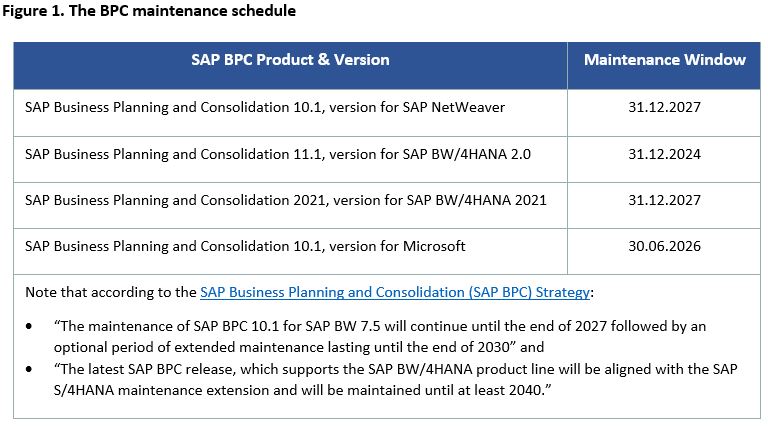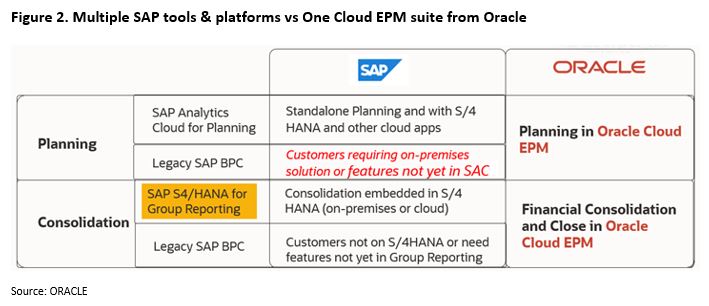For over 18 years, SAP Business Planning and Consolidation (SAP BPC) has been the primary on-premises planning solution for SAP customers. But BPC has not kept pace with EPM innovation[1]. As organizations worldwide continue to migrate to modern cloud platforms, Oracle Cloud EPM has become a leading solution suite that many SAP BPC users have already, or are considering migrating to.
Due to SAP’s fast-approaching end of support for various versions of SAP BPC (See Figure 1), many BPC users are considering what direction they will take. They have the option to migrate their BPC applications to other SAP tools such as SAP Analytics Cloud for Planning, S/4 HANA, and/or other SAP 3rd party partner tools, or they can consider other modern, cloud-based EPM solutions that are available today.

Source: SAP
SAP BPC customers realize that they need to transition to a modern Cloud EPM platform to meet their goals of modernizing their finance processes with AI/ML-driven technologies, extended planning and analysis (xP&A[2]), and other EPM processes beyond FP&A in order to achieve enterprise-wide connected planning that generates high-value and strategic business outcomes.
Examples of some challenges SAP BPC users are facing:
- How do we leverage our HR systems to plan for attracting, hiring and retaining top talent?
- How do we leverage AI and Machine Learning to modernize planning in finance and across other lines of business?
- How do we connect and collaborate with line of business plans across the enterprise?
- How do we quickly and cost-effectively migrate to a modern and complete cloud EPM platform?
- Should we take a Hybrid planning approach with SAP Analytics Cloud for Planning and other dissimilar tools, or utilize just one complete and unified EPM solution?
- Where do we start? Who can help guide us?
- Will we be able to migrate fast enough to enable our business the grow and thrive?
As an SAP BPC customer, you have the choice of either redeveloping your existing BPC applications with other SAP offerings which are predominantly based on some newer, some legacy, and some third-party partner-based tools, or you can move to a modern cloud EPM solution which has everything you need in one common, unified, and integrated platform that is developed and supported by a single provder. Let’s look at these two options in more detail.
Migrating to SAP tools
Rather than building a complete, purpose-built cloud EPM solution suite that addresses all EPM business processes in a single integrated and unified platform, SAP has taken a siloed approach by providing planning capabilities in SAP Analytics Cloud for Planning, Consolidations in SAP BFC, S/4HANA, and several other EPM processes using additional legacy SAP tools, and others such as Account Reconciliation, Tax, and Narrative reporting using third party partner tools.
To accommodate their legacy BPC customers, SAP has also proposed a hybrid planning[3] short-term solution that may work for some BPC customers, but careful consideration of various costs and effort associated with implementing this approach is recommended, as it requires multiple technical considerations[4] and potentially involves multiple platforms and tools (see Figure 2).
This approach involves combining SAP Analytics Cloud for Planning with BPC which may seem easy to do, but SAP’s own documentation[5] indicates that this requires comprehensive knowledge to integrate both platforms at the data, application, and workflow layers. This is not required with Oracle Cloud EPM as it virtually eliminates this multi-tool approach by delivering a single, and complete platform for all cloud EPM use case requirements.

Technically, and with enough time, money, and specialized resources, all these SAP tools and platforms could conceivably be made to work together, but BPC customers would likely need to deal with potential challenges such as:
- Different user interfaces (UI)
- Different tool technologies (languages, platforms, etc.)
- A mix of Cloud and on-premises deployments
- Multiple points of vendor support
- Multiple points of tool integration
- Multiple tool administration
- Different skill set requirements
- Different and questionable underlying AI capabilities
- Multiple tool upgrade cycles and version control efforts between tools
All of these can drive higher TCO and overall implementation and ongoing administration complexity while potentially impacting system stability and availability if any one of these disparate tools develops issues.
Oracle Cloud EPM as the better migration path
Oracle Cloud EPM delivers a complete, integrated, and unified software-as-a-service (SaaS) EPM suite. The depth of Oracle Cloud EPM’s capability includes advanced AI innovation such as predictive planning and automated data analysis which can deliver fast business value.
With Oracle Cloud EPM, SAP BPC customers can enhance and optimize their financial close and planning and budgeting processes to run in a unified, single platform which is purpose-built to support all other EPM use case requirements without having to depend on multiple tools, platforms, and vendors. This can significantly lower your migration, integration, and administration costs while speeding up time to value and making it easy for you to implement other Oracle Cloud EPM modules at your own pace.
Why Oracle Cloud EPM is the Smart Alternative for SAP BPC Customers
- Oracle Cloud EPM is a Leader in several leading Analyst reports[6].
- Oracle Cloud EPM provides comprehensive capabilities in a complete and unified Cloud EPM platform.
- Oracle Connected Enterprise Planning (xP&A) is a fully mature and proven solution that is part of the complete Oracle Cloud EPM developed and supported by one vendor, Oracle.
- Oracle Cloud EPM is a mature, proven, intelligent EPM suite on a single platform with leading AI and ML innovation.
- If you are considering extended EPM capabilities in the cloud such as Consolidations, Account Reconciliation, Narrative reporting, Tax, etc., these processes are already part of the complete Oracle Cloud EPM suite.
- Oracle Cloud EPM has built-in Analytics, advanced reporting, and real-time integration with Oracle Analytics Cloud if you require more comprehensive analytics capabilities across your enterprise.
- Oracle has experienced SAP BPC migration partners to help you migrate successfully.
- Oracle helps you develop your own EPM Center of Excellence (CoE) which helps drive continuous innovation. Learn how to create and run an EPM center of excellence.
Discover Oracle Cloud EPM today
Take the first step to migrate to Oracle Cloud EPM. Customers are choosing Oracle for our complete and purpose-built cloud EPM platform instead of struggling with the complex implementation, administration, and added costs related to other vendors’ incomplete and fragmented tools and technologies. Oracle Cloud EPM addresses all your EPM use case requirements in a single, unified, and complete cloud EPM platform developed and supported by Oracle.
Why settle for an incomplete portfolio that also relies on additional tools from different vendors to fill EPM application gaps in order to get all the functionality you need? Or waiting for a costly, time-consuming, integration, and customized development effort? Take the next step and contact us to explore the vast benefits thousands of Oracle Cloud EPM customers are experiencing today with the leading complete cloud EPM suite of applications.
Contact us today to get started on your migration path to Oracle Cloud EPM.
Additional resources
- Oracle Cloud EPM for Planning, Budgeting, and Forecasting
- Why companies choose Oracle Fusion Cloud EPM over the competition
- Compare Oracle EPM to SAP for more details
- Why migrate from SAP to Oracle Cloud EPM?
[2] https://www.gartner.com/en/documents/4005024
[6] https://www.oracle.com/corporate/analyst-reports/applications/
